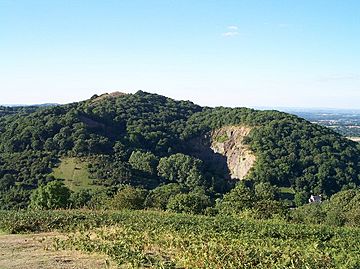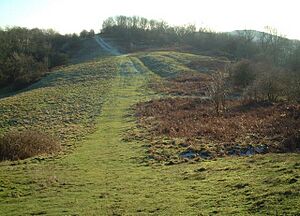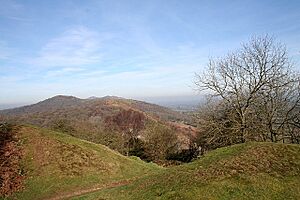Midsummer Hill facts for kids
Quick facts for kids Midsummer Hill |
|
|---|---|

Midsummer Hill from Ragged Stone Hill
|
|
| Highest point | |
| Elevation | 284 m (932 ft) |
| Geography | |
| Location | Malvern Hills, England |
| OS grid | SO760375 |
| Topo map | OS Landranger 150 |
| Geology | |
| Age of rock | Pre-Cambrian |
| Mountain type | Igneous, Metamorphic |
| Climbing | |
| Easiest route | Hiking |
Midsummer Hill is a cool spot located in the Malvern Hills in England. This range of hills stretches about 13 kilometres (8 mi) from north to south. It sits right on the border between Herefordshire and Worcestershire. From Midsummer Hill, you can see Eastnor Castle in the distance. The hill itself is 284 metres (932 ft) high. Just to the north, you'll find Swinyard Hill.
Midsummer Hill is famous for its ancient Iron Age hill fort. This fort covers both Midsummer Hill and Hollybush Hill. It's a very important historical site, so it's protected as a Scheduled Ancient Monument. Natural England owns the land. You can visit the hill fort by following a path from the car park at British Camp on the A449 road. Another path leads north from the car park in Hollybush on the A438.
Exploring Midsummer Hill Camp
The hill fort on Midsummer Hill is quite special. Its huge walls, called ramparts, and ditches surround not just one, but two hills and the valley between them. Some experts think that a natural spring in the valley made the hill fort even more important to the people who lived there. It might have been a place with special meaning.
These ramparts and ditches were built around 390 BC. People believe that about 1500 people lived in this settlement. The fort was used for many years until it was sadly destroyed by fire in AD 48.
Midsummer Hill's Cultural Connections

Midsummer Hill has also been part of some interesting theories. A writer named Paul Devereux wrote a book called The Ley Hunter's Companion. In it, he suggested that a 10-mile long invisible line, which he called the "Malvern Ley," passed through several places. These places included St Ann's Well, the Wyche Cutting, a part of the Shire Ditch, Midsummer Hill, Whiteleaved Oak, Redmarley D'Abitot, and Pauntley. This idea connects Midsummer Hill to a larger pattern in the landscape.
Images for kids



